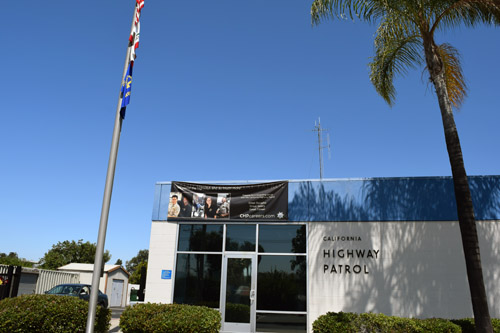
-53rd in a series-
Exit 20, Greenwood Drive, El Cajon, California ~ CHP El Cajon station
By Donald H. Harrison
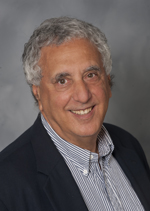
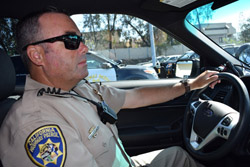
EL CAJON, California — Most of the 31-mile stretch of Interstate 8 between Greenfield Drive (Exit 20) and Buckman Springs Road (Exit 51) is known to California Highway Patrol officers like Kevin Pearlstein as Beat 83. Amid its climb to an elevation over 4,000 feet are beautiful views and vistas that the tourist can see. But, for Pearlstein and the 110 other officers assigned to CHP’s El Cajon station, this road also prompts vivid memories of wasted lives.
I met Pearlstein, who celebrated his 18th anniversary with the CHP in June of 2015, for a media “ride-along” from the CHP offices at 1722 East Main Street in El Cajon, where by appointment, motorists may receive free instruction on the proper way to install an infant car seat. Here, too, motorists may bring their cars in to show that they have complied with vehicle “fix it” orders issued by any law enforcement agency in the state. There is no charge for either service.
In different parts of the United States, there are stories of “speed traps” where law enforcement officers wait to catch speeders in order to raise revenue for their towns. Nothing like that happens with the CHP, commented Pearlstein, because “CHP receives no money” from the tickets it writes. “We don’t get a penny, and that is the way the governor wants it. We don’t want anyone to think it is a revenue generator. We write tickets because tickets save lives.”
In fact, commented Pearlstein, who went through a pre-drive check of his snazzy assortment of radios, lights and siren, computer, weapons (a Remington 870 shotgun and an AR-15 rifle), and radar, just by the CHP “showing the door”—that is, making their marked patrol cars very visible on the area highways—lives are saved because motorists are reminded to slow down and do the right thing.
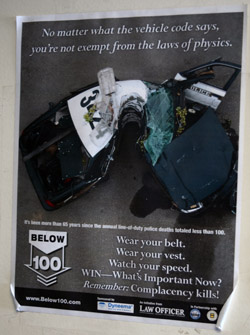
A gate with a sign telling how many days (42 days when I visited), it had been since a CHP officer was in an accident opened to allow us to leave the CHP yard. Pearlstein guided his cruiser up the eastbound Interstate 8 ramp, and, as we got to know each other, he shared a story of growing up with his father’s Chanukah and his mother’s Christmas celebrations. Still today, his family celebrates both holidays. Additionally, he has attended a lot of family bar and bat mitzvahs, and one of his cousins—Elise Pearlstein—is a film maker perhaps best known for the documentary Food. Additionally, for family use only, she interviewed their common grandmother about how she had to hide out during the Holocaust, “kind of an Anne Frank story.”
Kevin Pearlstein had grown up in San Diego, graduating from Patrick Henry High School and from San Diego State University where he majored in political science and minored in sociology. A relative who had worked for the San Diego Police Department suggested he consider a career in law enforcement, and the idea grew on him. It took two years before he was accepted into the CHP Academy, and over six months of intensive training before he earned the right to be called an officer. His first assignment was in northern Orange County, but later he was able to be transferred to his home turf, San Diego County. After his 16th year with the CHP, he accepted a tour in the public relations department, which involves teaching students in public schools about safety and serving as a spokesman to the media in the event of newsworthy cases in the East County. He enjoys the assignment, okay, but he said he hankers to get back on patrol, where every day is different, and challenging, and where law enforcement officers enjoy a special camaraderie.
Some people mistakenly think that the California Highway Patrol’s jurisdiction is only on highways, said Pearlstein, but out in rural, unincorporated portions of San Diego County, it also divides responsibilities with the San Diego Sheriff’s office. Sheriff’s deputies investigate criminal matters, while the CHP is responsible for traffic. If you’re driving drunk, or over the speed limit, a CHP officer can pull you over, whether you’re on a highway or a back country road. They also are there to help if your car is stalled or you’re in an accident. Sometimes, Pearlstein said, officers from other law enforcement agencies will deride the CHP as “Triple A (Road Service) with a badge” but they make such comments out of jealousy. The CHP is harder to get into than most law enforcement agencies. “We have 20,000 applicants and out of that maybe 50 will make it.” In East County, he said, such inter-agency rivalry is at a minimum. Most of the people serving there have been with their respective agencies for long times and are happy with their careers, according to Pearlstein.
As we approached Dunbar Lane, Exit 27, Pearlstein recalled the time that a mother who was taking her son westbound to Valhalla High School lost control of her vehicle, and rolled her car on that particular stretch of highway. “He wasn’t wearing a seat belt and was ejected and killed. She survived. The dad was so distraught later in the day that he got on the freeway the wrong way at Tavern Road (Exit 30) and he was trying to go head on with vehicles and he finally did it and he hit this young girl head on. Fortunately she survived, but he didn’t. That was right here.”
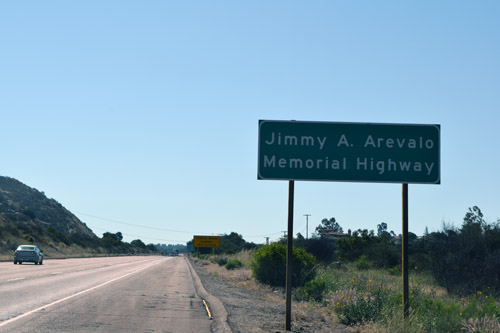
I barely had time to picture the suicidal incident before Pearlstein gestured to a sign up ahead marking the Jimmy A. Arevalo Memorial Highway. “There was a young girl,” Pearlstein related. “She was a valedictorian student in high school, and she was graduating from UCSD summa cum laude. She was just a week away from graduation. She went out dancing and she got drunk, the alcohol in her blood testing at .12. She crashed and came to rest in the fast lane on her roof. A Good Samaritan, Jimmy Arevalo, a teacher from El Centro, pulled his truck up, got out, and was trying to assist her. He was on 911 talking to our dispatcher, and while he was doing that, another drunk driver doing 80 miles an hour, with no braking apparatus, killed both Arevalo and the girl. The dispatcher heard it all on the radio. ‘I’m over here – Oh my God!’ and the lights went out. The driver who killed them had moved here from Washington, was here only a month, had no license, no insurance, and several drug convictions. She was driving to a casino. Now she is serving 9 ½ years in state prison on a plea bargain. Mrs. Arevalo says her husband was killed by two drunk drivers: the first being the girl who started the whole chain of events, and then the next driver.”
When Pearlstein stops a motorist on suspicion of drunk driving, he conducts a number of “field sobriety tests” always in the same order. Sometimes, if a person is elderly, “they obviously can’t stand on one foot, so I am not going to give them that test, but if a person is in the 30s, I will do the same tests that I always do. A lot of what we do is routine, and that helps us if ever the arrest is challenged in court. Someone might say ‘How do you know you did the Romberg Balance Test as your second test?’ I answer ‘Because I always do; I have made one thousand DUI stops…”
If the motorist is arrested on suspicion of drunk driving, he or she will be asked to take either a breath test or a blood test. One or the other must be chosen, because “when you signed for your driver’s license, you said if ever you were arrested for drinking and driving, you would submit to either a blood or breath test. The breath test is immediate. Once it is done, it can’t be done again; there is no way to retest it, whereas blood can be retested. The crime lab does it for us; a defense lawyer can have it done independently. We used to have to offer urine as well; that God, they don’t do that anymore.”
If a motorist takes a breath test and it shows an alcohol level of over .08, “then I’m going to read a Trombetta advisement to you explaining that a breath test cannot be tested by another agency, however if you wish to provide an additional sample at no charge to you, we can have a blood sample drawn and sent to the crime lab for evaluation. And then we check a box that Trombetta was offered.”
I asked at what point does a drunk driving suspect need to be read his or her Miranda rights—the right to remain silent, or to have an attorney present during questioning. “Arrest plus interrogation equals Miranda,” Pearlstein replied. “So if I arrest you for drunk driving, I have already made up my mind that you are drunk and I don’t need to ask you further questions. Some people do; I don’t. I don’t need anything else from you… but if I were to ask questions because there was a hit and run in the same area, with a car fitting the description of the person who I’ve arrested, then I would Mirandize him, and if he waived his right and wanted to talk, then I would ask him, ‘hey were you on that road, and could you have hit that car?’”
At East Willows Road (Exit 36) Pearlstein said “whenever we have to shut the freeway down, maybe because of high winds, we will always shut it down here at East Willows, and people will turn around and go back or park on the shoulder and wait for us to reopen it. We have had 75 to 85 miles per hour winds at the Pine Valley Bridge (Exit 45), Sunrise Highway (Exit 47), and Crestwood (Exit 67). Once the first big rig or RV overturns, it’s over. We shut it down. We shut down traffic for high profile vehicles and that is the time when we will run escorts for passenger vehicles.”
In an escort situation, he explained, “I will be the lead vehicle and we will start going and people will start following me. I don’t have to zig zag, I straddle the lanes, with my (flashing) lights on. Motorists usually get the point. I will go 20 miles to 30 miles per hour, trying to get someone over the Crestwood summit. On the other side, in El Centro, the CHP will close the grade so no one can start (west-bound) up the hill.”
The winds being normal, we drove at regular speed to the Ellis Wayside Vista Point (Exit 37), named for the family of pioneer Charles Ellis who came from Norway in the 1880s and settled in the Descanso area in the 1900s. He was the surveyor of the Viejas Grade Road, which made travel easier between the Imperial Valley and western San Diego County. In the past a plaque marked the spot, but vandals pried it off its cement pedestal as well as a facing plaque describing the viewpoint which is 40 miles inland from the ocean. A copy of the plaque, which can be found on line, informed that “the land around you is a portion of the Sweetwater Watershed, which is protected by the Forest Service to supply water from winter rains.” The brush, the plaque further explained, is chaparral, which in dry conditions can be quickly ignited, resulting in “large, extremely hot brush fires” that damage the watershed, and result later in “floods, mudslides and severe erosion.” The plaque concluded with a plea to “please protect this watershed. Be careful with fire at all times, and use your ashtray as you continue your travel.”
Pearlstein said the vista point also is the place where the driver of a big rig, distraught that his wife had left him, drove the rig as fast as he could from a parking area “and launched it down the hill. He ended up way down there, and it took three or four days to pull the truck up, with three or four tow trucks pulling it up piece by piece. It was a major headache.”
Suicides, alas, are not confined to the vista point. The Pine Valley Bridge, at Exit 45, is another structure that attracts the terminally depressed. “I worked the San Diego office of CHP and the Coronado Bridge is the same thing. People do it; it is just crazy. The thought of suicide has never popped into my head; I can’t imagine what they were dealing with that they thought that was the best option.”
We got out of the car and stretched at the vista point. Pearlstein said that drivers should take constant breaks, at least every two hours on long trips. Furthermore, he advises people who will be traveling long distances on the highways to “make sure your tires are good, and if it is the winter season make sure your wipers are good. Before I go on a trip, I always make sure the tires are balanced and rotated, and I get the oil changed. Make sure that your vehicle, first and foremost, is going to make it. Get plenty of sleep the night before, and if you have two people who can drive, split the driving up. And give yourself time! What we find on a Friday afternoon, coming west, a lot of people from Arizona are doing 85, 90, 95, just flying out here, in such a hurry to escape the heat, and Sundays they are out of control trying to get back.”
He said that in 2014, the El Cajon office of the CHP made 72,000 traffic stops. “We didn’t write 72,000 tickets. A lot of them were at night, drunk driver checks. You check them and if they are sober they go on, but it is still an enforcement stop.”
What does he say about the oft-repeated charge that law enforcement officers single out minorities for tickets?
“Say we are sitting here (at the vista point) watching traffic and that truck goes by right there, can you tell who is driving that truck, or that car behind him? You have no idea. I’m sitting on the side of the road, and I am running my radar and watching my mirrors and I see a car. I think he’s doing maybe 85, and I lock on the radar, and he’s actually doing 87. I have no idea who that person is until I am walking up, looking through those windows, absolutely no idea.”
Whether he gives a ticket, or issues a warning, can depend upon the attitude of the driver. The speed limit in this area of the freeway is 70 miles per hour. “If you are doing 95 miles per hour, you are getting a ticket. If you are going under 80 and I stop you and you’re respectful, and you say something like ‘it got away from me, my kid was crying,’ I might say, ‘hey, try to slow down a bit, and drive carefully.”
On the other hand, “if I say you were doing 85, and you smack your hand on the seat and say, ‘I was only doing 80!’ that’s a ticket. But if they have a good attitude, ‘sorry it got away from me, my fault, I’m sorry, officer,’ that person is so much likely to get his stuff (driver’s license and registration) back.”
The law permits such discretion, he said. “There are three words in our policies: ‘may,’ ‘should,’ and ‘shall.’ ‘May’ is you ‘may do it; ‘should’ is you probably should do it, and ‘shall’ means you must do it, and if you don’t you are in violation of policy. If someone is going five miles over the speed limit, it is ‘shall’ stop and ‘should’ cite. It is not ‘shall’ stop, ‘shall’ cite, so it’s our discretion. It all depends on the interaction with the driver, what their attitude is toward law enforcement. I don’t care if they are Hispanic, white, African American, male, female, I don’t care. I don’t care if they are Jewish and wearing a yarmulke — ‘Pearlstein? you’re going to give me a ticket? I’m Schwartz’ – that doesn’t matter, it means nothing.”
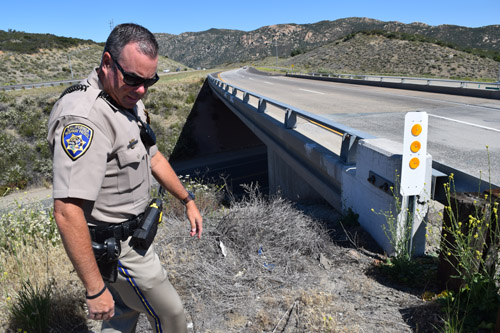
We continued to Exit 40, which is the junction of Interstate 8 with State Route 79. This, said Pearlstein, was the site of “the biggest crash I ever had. It was a truck loaded with illegal immigrants from Mexico. They loaded up down by Tecate and came up Highway 188 and as they turned onto Highway 94, the U.S. Border Patrol attempted to stop them. They attempted to run over one of the agents, and so a huge pursuit ensued, and there were 17 people in the back of this truck and three in the front: the driver, an innocent young lady, and the smuggler or coyote. They ended up crashing into the bridge abutment here over the 79, and all 17 people in the back got ejected onto the 79 state route down below. Three of them were killed, eight or nine had major injuries. Fortunately, the driver and the coyote were trapped in the cab; they wanted to run but they couldn’t, so we were able to prosecute them. Each of them got 25 years to life per each death, so they’ll be locked up forever. They will never be out.”
We continued to the exit at Buckman Springs (Exit 51), marking the beginning of the territory which four resident CHP officers are responsible for patrolling. From their homes, they cover the Interstate 8 from this point to Exit 77, In-Ko-Pah Park Road, which sits on the border of San Diego and Imperial Counties. They also are responsible for Highway 94 to Tecate. They fax their reports from a sheriff’s substation, and twice a week receive mail and notices from the home office, brought to them by senior volunteers.
As we headed back to the El Cajon station, I asked Pearlstein whether there were any driving tips he’d like to pass onto readers.
He said if people want to avoid injury accidents, they should be sure to follow four rules:
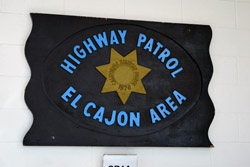 1) Drive the speed limit
1) Drive the speed limit
2) Wear seat belts
3) Don’t drink and drive
4) Don’t talk or text.
The last one caught me by surprise. Weren’t we, in fact, talking at that very moment?
Yes, he said, “but we are both paying attention to the road. That is called ‘shared awareness.’ We are both watching the traffic conditions. If there is some traffic stopping up there, and you see it, you would say ‘Whoa, look out!’ But if I am by myself in a car, and I am in a perfectly legal conversation (that is with a cell phone hooked up to a speaker/ microphone), I have lost shared awareness. Fifty percent of what I am seeing, I have lost because I am focused on the conversation. My focus isn’t driving. You are four times more likely to crash if you are talking on the phone compared to someone who isn’t on the phone. When you are texting, you are 23 times more likely to crash. Texting involves three separate distractions: your eyes are off the road (as you look down at the screen of your cell phone); you have one hand off the wheel, and your mind is off the road.”
During our outing, we had the chance to schmooze about Pearlstein’s perceptions of TV dramas depicting law enforcement. He said that when he was a boy, he used to love to watch the television series CHiPs starring Eric Estrada as trainee “Ponch” and Larry Wilcox as his more seasoned partner Jon Baker. The TV series influenced Pearlstein’s desire to become a California Highway Patrolman. Now when he sees reruns, he laughs, he just has to roll his eyes at some of the unlikely plots. A far more realistic portrayal of law enforcement, he said, was the television series Southland, which no longer is on the air. As for the various CSI (Crime Scene Investigators) shows, “I can’t get into that, I mean, people in the crime lab out there doing interviews? You think, ‘where’s the rest of them? Where’s the police force?’ I mean really, these two people are doing everything. I used to like Law and Order back in the day, especially when Jerry Ohrbach was in it.”
*
From Exit 20, turn north on Greenfield Drive, and left on East Main Street. CHP station is on the left.
*
Harrison is editor of San Diego Jewish World. You may comment to him at donald.harrison@sdjewishworld.com
*